The second big cross-country trip in the Helicycle was an exciting thought. When my great friend, Mark Hornsby, an ex Helicycle builder and current Mosquito XET builder, said that I should make the trip and meet him at the Trenton, Florida Helicopter Fly-in, I agreed and took him up on the challenge.
It was also great to get the support from Kathy and the home front. My trip to Homer’s a year and a half ago and an additional 110 hours on the ship gave me the confidence. Pre-trip activities included fuel stop planning and loading up a few items such as fuel hose adapter in my small under seat storage compartments.
The trip would take six flight hours, diversions and delays would have to be added to that. This time of the year, daylight hours are short and a few items to accommodate an on-the-road overnight stay were also loaded. With only limited storage on the Helicycle, I sent my luggage ahead with Mark. On other trips I have sent luggage ahead via UPS.
This trip was to start on the day after Christmas. It seems to never fail that I start trips 30 minutes later than planned and this was no exception. After a good pre-flight inspection, telling Kathy and the dogs goodbye, I was on the go, headed 89 miles east to my first stop, Picayune, Mississippi.

LEFT: What’s not to smile about Ready to go, good weather, well planned trip. Couldn’t be better.
RIGHT: New ideas and of course hangar flying galore added to everyone’s enjoyment of the Trenton Fly-In.
The weather was not the greatest, ceilings below 1000 feet with mist, so visibility was barely three miles. The temperature was about 68 degrees and I was sure glad I wore my leather jacket. The Garmin 496 was a great tool to have along, showing the towers sticking up into those low clouds!
A Helicycle draws a crowd. Yes I know, that was an under statement. I failed to add time to my flight planning for visiting at the fuel stops. At the first stop, Picayune, at least four different companies have helicopter operations there.
I’m guessing at least one pilot and one mechanic from each came out to look. After visiting, taking care of the 13-gallon fuel ticket and having a sip of coffee, I burnt up 45-minutes when I should have been gone in 15. All was good, those who know me, know I like to visit.
On the go again with Mobile Regional the next stop, an 85-mile leg. At twenty miles out from KMOB, a radio call and subsequent transponder code made the experimental helicopter a welcome guest.
By the time the main rotors came to a stop on the ramp there were several more line guys on the scene than were really necessary to take care of one little helicopter. The FBO there is really a good one though the fuel prices were the highest of the trip. I’m glad that I only had a 12-gallon top-off.
Leaving the Mobile airspace, the departure controller let me follow Interstate-10 across the north end of Mobile Bay; over water flight in other than a seaplane is high on pucker factor. The straight line distance on next leg to Crestview Florida was 105 miles.
I considered for a moment following 1-10, but it diverted well to the south. I opted for the shorter distance versus being near a main highway. That route took me directly over our Navy’s Whiting Field, which was closed for the holidays. A really cool sight at 500 feet AGL, the place where most of our Naval aviators get their wings.
Weather was not nice on the last six miles going into Crestview. Ceilings were 500 feet and ragged and the mist was thick, making visibility a mile or less. I have been a fixed-wing scud runner for decades and this helicopter thing was taking it to new “heights”.
The airport came into view and the set-down on the ramp was uneventful, just in time as the fuel gauge was indicating about l/8th remaining. The top-off took 15 gallons. One note about Crestview; the lineman was the only person to come out and look at the Helicycle and that was his job, he was paid to come and talk!
The mist at Crestview was as thick as it could be and not be called rain. Ceilings and visibility remained low. I came really close to shutting down there for the night, to let this weather system pass.
Looking at METARs on the Garmin 496 showed much improved weather to the east, so I fired up the Solar turbine and was off. Once airborne, visibility and cloud clearance was not a problem. After about 10 miles it was solid VFR.
The next leg was 80 miles to Marianna, Florida. After shutdown on the ramp, a med-evac crew who wanted to know about my ship came along. It was late afternoon and the gentleman who manned the FBO was having a light siesta, I hated to disturb him. We put in 11.3 gallons of jet-A and I was off again.
Tallahassee was the next stop. It is only 58 miles. I did not want to try the only other fuel stop along the route, which was 108 miles against a headwind. After landing at TLH, at least six linemen came out to look. A lot of service for nine gallons!
I have failed to mention so far that at all of the fuel stops I had to use my fuel nozzle adapter in place of the duckbill and large diameter filler on the FBO hoses. It would have been really difficult without that adapter.
Watch This Video!
In the air and on the go from Tallassee, I had about 30 minutes of daylight for a one hour and 20 minute flight to Trenton. After about 15 minutes I got into a tailwind! The Garmin’s guess on en-route time was steadily dropping. By this time it was dark.
Visibility was unlimited, the air was smooth and all was well…until the tailwind turned on me. Foiled again! I did not want to try and find an unfamiliar field, at night, and low on fuel. What are those lights off to the right? Cross City, only nine miles away. That would be the final stop of the day.
The direct-to nearest airport feature of the Garmin headed me toward the un-lit airport. A few clicks of the of the VHF transmit button on Unicom frequency turned on the runway lights and rotating beacon. The VASI lights assured me that I was on a safe approach to hover on the runway. Hover taxi between the blue taxi way lights to the ramp and the flight is complete.
I called Mark Hornsby who had taken a commercial flight from Louisiana earlier that day. He had a rental car and would be there in twenty minutes to pick me up. The Helicycle was to spend the night on the ramp. I had packed an el-cheepo plastic drop cloth and some clips to cover the ship if needed.
When wrapped, it looked like an insect that a spider had made a cocoon around to snack on later. Mark had me back to Cross City early the next morning. We topped off the Helicycle with 13.2 gallons. I fired up and was off on the last leg of the journey. Finding the fly-in was easy.
Mostly because of Google map pictures and preliminary information, (along with my superior navigation skills!) and a GPS that will get you to a fraction of a foot to where you want to go. The Trenton Helicopter Fly-In is a really cool event.
Dwight Junkin and crew are to be commended. I made new friends and re-enforced old ones. One interesting story is about a gentleman who came to the event from Louisiana who told me that someone near him has a Helicycle, he saw it fly over his home the day before. I told him that was me on my way to Trenton!
There was plenty of flying, looking, visiting, and good times at the helicopter fly-in. I got to fly the Mosquito AIR and XE. Flying Andy Redmond’s Mosquito AIR was a blast! The Mosquito XE, with its cabin and control feel, reminded me so much of the Helicycle.
Flying turbines for work and play will spoil you when it comes to engine RPM management. I had never flown a non-governed helicopter before flying the Mosquitoes. The power available with the 2-strokes made it effortless in just a few minutes.
My Helicycle started acting up on the second day. I could not isolate the symptoms much less the cause. Starting problems, RPM excursions, voltage excursions and a battery that would some times loose it’s charge, were all on the changing list.
Some folks that are a lot smarter than I am were baffled. With help from Cam Haberger, we found the problem. A turbine exhaust heat shield had melted some insulation on a battery cable resulting in an intermittent short. A quick repair and problem solved!
Sooner or later it is time to head home. That morning I got up early and bundled up because of the cold front that come through the evening before. Dwight was up milling around and gave me a wave-off as I departed in the still cold air. I had put in a total of 30 gallons of fuel while at the Trenton Fly-In and there was enough fuel onboard to get me the 57 miles to Perry, Florida.
Air-taxiing across the ramp at Perry, someone came on Unicom to inform me that I had something dangling on a wire beneath my helicopter. It is not good to think of parts hanging off your aircraft. Not real good PR. either!
The right nav light bracket holding clamp had broken. Some safety wire from one of the fine local gentleman pilots had the assembly temporarily repaired. After a top off with 11 gallons of fuel and some coffee and visiting, I was on the go again.
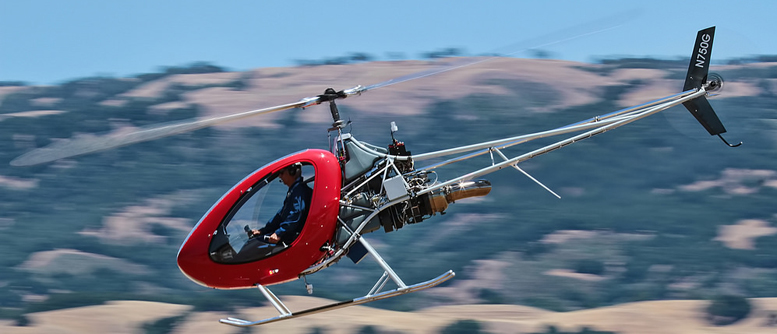
PHOTO CREDIT: Mark Von Raesfeld
The 52 miles to Tallassee would be a good leg, not too long, to stop and check the temporary repair. It was a good eight gallon quick turn also. While there, I called Andy Redmond to see about stopping in at his home, per his invitation. The automotive street map mode on the Garmin 496 let me enter a direct-to way point for the 87 mile leg to his address.
The Redmonds have a beautiful home on a lagoon in Panama City, with a heli-pad! Their hospitality is great. We went to lunch, stopped at the local marine supply for helicopter repair parts and filled up two fuel containers.
The Helicycle took those 11 gallons and Andy went back to the store for a little more fuel while I made the repair to the light bracket. It took two more gallons to top off. I had a good visit.
Flying the high traffic corridor along the beach between Panama City and Gulf Port has always been fun and really no trouble. I have been doing it for many years and OH! the sights that I have seen! This time was no exception.
The departures from Destin that come right at you, AC-130 Gunships in the pattern at Hurlburt Field, helicopters patrolling the beach and a C-130 at the same altitude (500-feet) and opposite direction!
All this did not bother me nearly as much as it did the controller who was handling my flight following. He was relieved when I changed my destination from Gulf Shores to Pensacola Regional, getting me off the beach.
It happened again at Pensacola Regional Airport, several helicopter company pilots and employees came out to see the little turbine powered helicopter. One of the pilots was Roger Buis who flies Otto the Helicopter. If you ever get a chance to see Roger and Otto at an airshow, do it, you will be amused and amazed!
As we visited, the fuel truck topped me off with 13 gallons and took the payment, all there on the ramp. That was a first. After talking and visiting more, I realized it was getting dark and I needed to get on with it.
Otto’s pilot suggested that I make it to Mobile Downtown airport where they would order for you, up to two pizzas with a fuel purchase. I could tell Roger had been there a few times!
As I got to the east side of Mobile Bay, it was dark. I had a fleeting thought of refueling and continuing on. Nahh! It had been a long day and I didn’t want to push it. Mobile Downtown tower cleared me to the ramp.
The FBO there is another great one. They let me wheel the Helicycle into the hangar and then let me take a courtesy car overnight to a hotel. I didn’t take them up on pizzas. Not bad for nine gallons of jet-A.
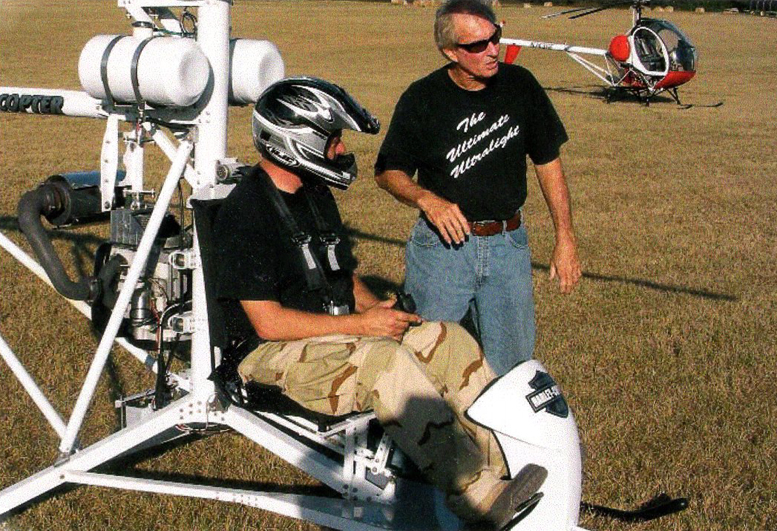
Jim preflighting with Andy Redmond in his Mosquito Air kit helicopter.
The next morning was a good one, two more flight legs and I’d be home; Mobile to Picayune and then home. At Picayune, another set of helicopter folks came out to the pumps while I put in 13.4 gallons. We talked awhile and I was able to fire up for the last leg home.
One hour later the trip was at its end. Kathy heard me coming in and was outside snapping a few pictures as I landed. My trusted hound Rocky, sat beside her and gave his customary howl to the sky as I let down.
The Helicycle has proven itself twice now on long cross country trips. Granted, the ship was not designed for that purpose, no storage and such. Its speed and novelty makes it a lot of fun. The 30KW modification (Editor’s note: The 30KW mod is a mod to the Solar engine to reduce the rated power from 160 shp to 80 shp which reduces fuel consumption from his 13.5gph to his present 10.9gph reported on this trip) on my ship really helps on range.
I am not using the aux tank because of CG considerations. If I were, I could get another 40 miles per fill-up… This trip totaled 1060 mile round trip distance which included the fun flying in circles at Trenton. Total time on the helicopter for the trip was 17 hours.
It was a fun trip and I am looking forward to the next Helicycle Flying Adventure. If anyone has any questions, com ments, or just wants to visit, send me an email or give me a call.
Jim Little
MORE INFORMATION: https://helicycleventures.com/
MORE INFORMATION: https://www.helicycle.com/
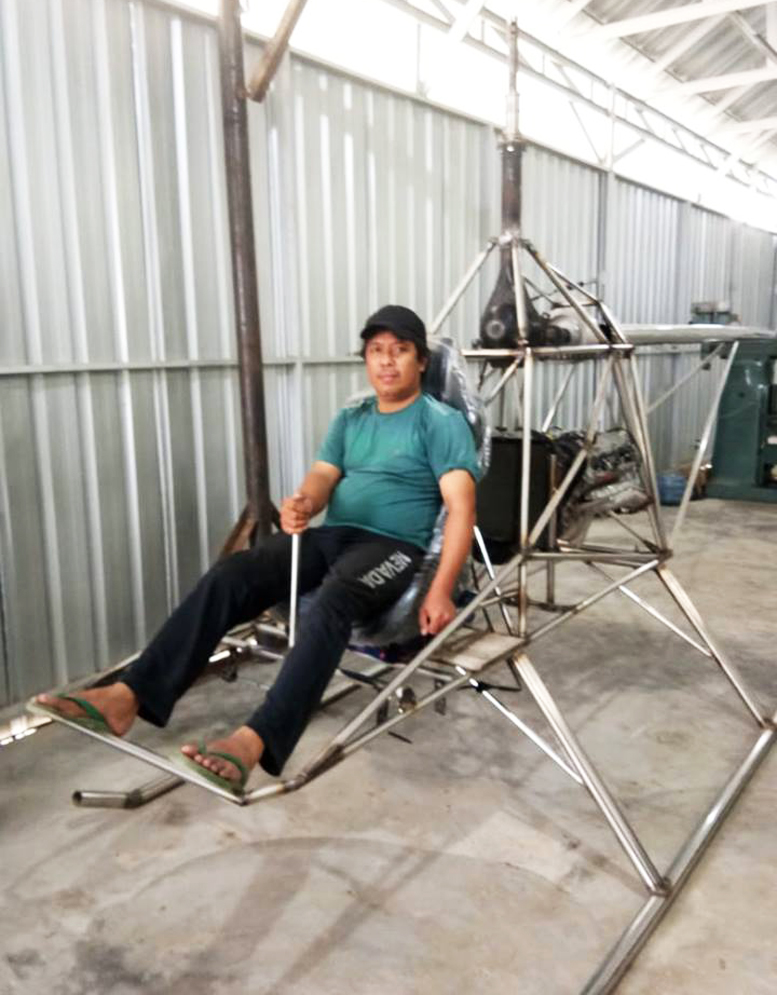
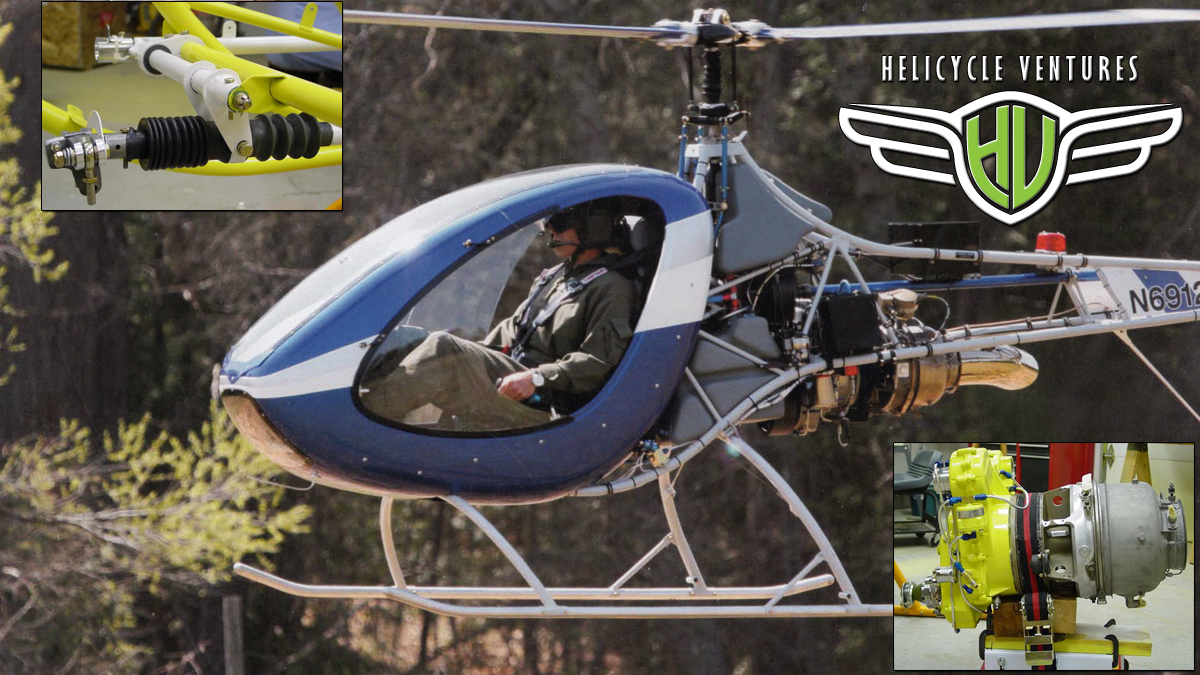

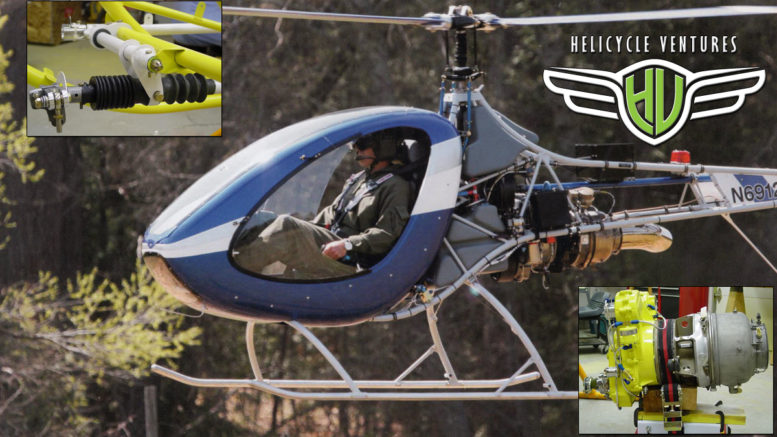
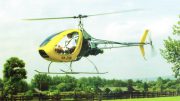
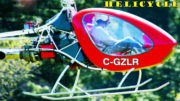
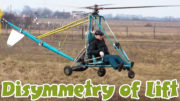
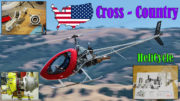
Be the first to comment on "Helicycle to Trenton"